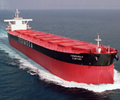Little impact on China spot iron ore market from stockpiles in India’s Goa: sources

The increased supply of Indian iron ore from Goa into the Chinese spot market is expected to have a muted impact on current dynamics despite high iron ore prices, market sources said in the week started Nov. 1.
The Indian Supreme Court granted mid-October mining lessees in Goa an extension until end January 2021 to remove iron ore that was mined on or before March 15, 2018, when a statewide ban on mining was imposed.
Market sources estimated the total stockpile volumes to be about 4 million mt, of which 1 million-1.5 million mt were likely to be exported.
Despite continued high price levels for iron ore into China, logistical constraints and fundamental differences compared with east Indian iron ore brands were seen as factors limiting any market impact of Goa iron ore supply.
One of the key logistical differences for the export of Goa iron ore would be a heavy reliance on barges to transport iron ore to the export port at Mormugao compared with trucks and rail in east India.
While several sources said lower logistical costs for Goa-based producers would provide increased price competitiveness, the availability of barges may prove to be a hurdle.
Lengthy truck queues to enter the port of Paradip and port congestions continued to be major issues for east Indian producers but Indian sources said logistical situations were more favorable toward larger producers, given the availability of higher transport quotas and individual own berths.
A lack of marketing compared with east Indian iron ore brands would be another hurdle, market participants said.
Goa iron ore has been largely out of the market after the mining ban, with its role replaced by Odisha-based producers, a seller said. For some of the brands that were previously reliant on ex-Chinese buyers like Japan, it would be a difficult transition to market into China, given different procurement preferences, the source added.
The current iron ore price volatility also presents a valuation challenge for buyers, especially with the obscurity of Goa iron ore in the spot market.
Indian iron ore cargoes are concluded at fixed prices, which present plenty of speculative risk, and while the sintering quality of Goa iron ore tends to be largely favorable, end-users may have to make a few adjustments to accommodate the usage of these products, a China-based trader said. In addition, supply of Goa iron ore is expected to be cut after January 2021 and end-users are likely to seek steep discounts on account of irregular supply, the source added.
These products are likely to be sold at floating levels to individual mills or landed and resold at the portside market, where prices are still higher than seaborne counterparts, another China-based trader said.
Quality variance
While branded products from Goa like Sesa fines may have an existing customer base and familiarity among Chinese participants, “recent offers were mainly unbranded low-grade products in the range of 52%-57% Fe, which would lend them wider discount compared to those with similar Fe levels in eastern India,” an international trader said.
End-users were also holding back on the uncertainty involved with the quality of these premined products. “The lower Fe content is acceptable as the sinter going into blast furnaces are usually less than 60% Fe in China, however, it is the variance of the product that concerns customer,” the source added.
“We have procured a few cargoes of 57% Fe Indian fines from eastern India in the third quarter this year, but the variance in Fe and moisture level was unfit with our demand, and we are concerned that the same would happen to the western Indian fines,” said a steelmaker source based in northern China, who was a user of western Indian fines before the mining ban in 2018.
Another end-user source, however, pointed to a lack of optionality in the low-grade segment this year as a potential factor supporting demand.
“Despite higher impurity levels, such Indian fines may be very useful in terms of cost-saving, especially for construction steel production, which has lower quality requirements compared to products like specialty steel,” the source said.
Source: Platts

 Hellenic Shipping News Worldwide Hellenic Shipping News Worldwide, Online Daily Newspaper on Hellenic and International Shipping
Hellenic Shipping News Worldwide Hellenic Shipping News Worldwide, Online Daily Newspaper on Hellenic and International Shipping





















 PG-Software
PG-Software